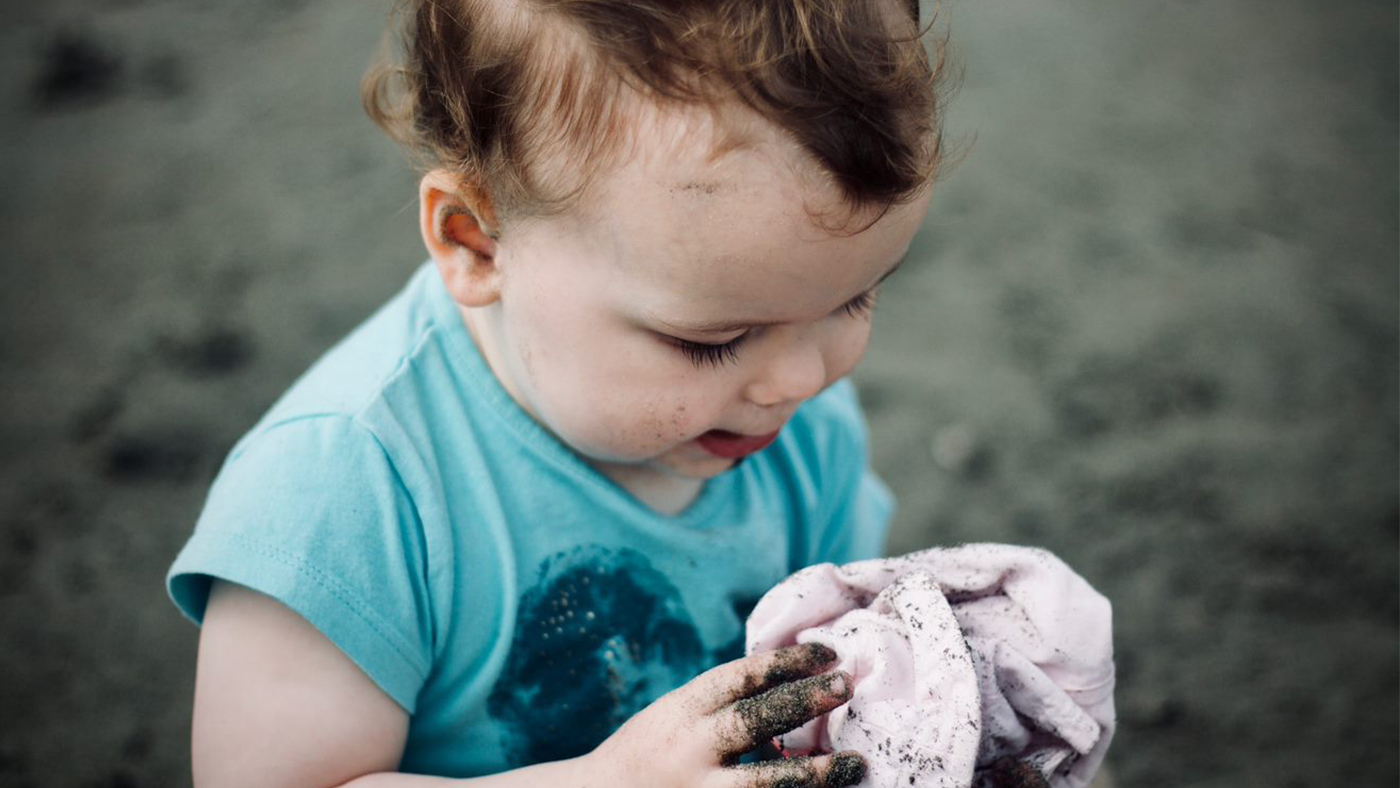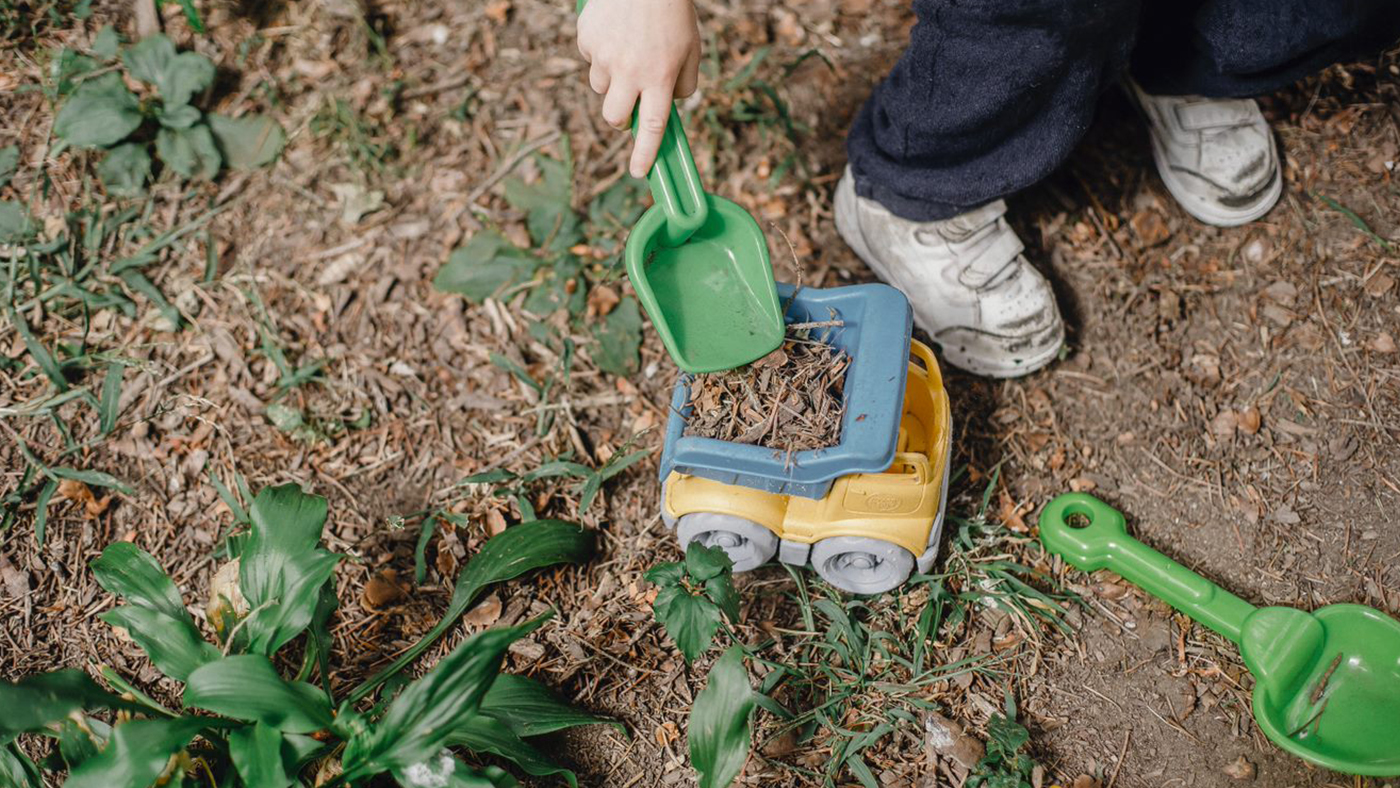Mud play – why you don’t need a mud kitchen
- Outdoors

Mud is possibly one of the most versatile resources your child can play with – and it’s free! As daunting as the prospect of adding mud to play can feel, it is also fun for grown-ups to get stuck in – even Dolly Parton sang the praises of mud at Glastonbury, getting her fans to chant along with her, “We can’t get enough of the music and the mud!”
While the most popular and well-known type of mud play, the mud kitchen, does have its benefits, there is so much more that you can do with mud at home. In this blog, we will share a few muddy play ideas to get you started.
Benefits of playing with mud
Playing with mud supports many areas of learning, crossing over our six streams of development here at My First Five Years. Children often use mud to recreate real-life experiences that they may have had, for example, they might use mud to make a cup of ‘tea’ and offer it to you. The founder of Montessori education, Maria Montessori, felt that children enjoy play based in reality, and want to explore using real-life objects and experiment with these resources to achieve different results.[1]
Let's take a look at some of the ways in which mud play supports learning in the My First Five Years streams of development.
Fine motor
Playing in mud often comes alongside handling small pieces of equipment that will support children to develop their fine motor skills. Often when children play with mud, they will be using items such as scoops, trowels, and cutlery, all of which help to strengthen muscles in hands, fingers, and wrists.[2] Even exploring the different textures and consistencies of mud with your fingers is great for developing strength and control.
Children exploring mud will also play with different textures and consistencies, and will learn what effect the pressure and grip that they use will have on items.
Cognitive
Using mud as an outdoor resource can be a great way to encourage creative play with young children. Children often enjoy recreating and experimenting with real-life scenarios that they have seen before. You may observe your child copying actions that they have seen at home in the mud, for example, mixing ingredients for a ‘birthday cake’.[3]
Playing with mud also helps to develop problem-solving skills. It is a good opportunity for children to carry out their own experiments with different materials, and play with cause and effect, observing what happens when they mix mud, water, sand, and anything else they can find.[4]

Language
Sensory and role-play based activities like mud kitchen play are great for language development. Children playing with mud will be using new vocabulary to describe what they are doing, and the new textures and sensory experiences that they may be having.[3]
Sensory
Mud is a great resource for incorporating sensory aspects into your child’s play. When playing in mud, your child will take part in brand new sensory experiences, perhaps even making their own mixtures full of different things, and also using found items like leaves, grass and twigs to create new textures. Playing with a range of materials in this way enables your child to discover new sensations, sounds, smells and sights in a pressure-free environment.[5]
Gross motor
As well as helping to develop fine motor skills using tools and handling smaller objects, mud can also be good for helping with gross motor development. When playing with mud, it is likely that your child is going to be lifting and moving materials using their full body. They will also mix and stir their muddy creations, which is great for helping to develop shoulder strength. Your child will be demonstrating control over their body and their movements, too.[3]
It’s not only handling mud that develops gross motor skills. When your child walks on mud, they may have to adjust their speed or gait – and it’s also great fun to slide on!
Social and emotional
Using mud in play is a good social activity, and will encourage children to discuss their discoveries with one another and take turns in conversation as they collaborate, plan and work together to achieve an outcome.[4]

So, what can we do with mud?
When thinking about bringing muddy fun into play with your child, it can be easy to jump straight into thinking that you need to have a perfect mud kitchen area in your back garden. While you may naturally want to confine it to a corner, away from other toys and activities, setting up a mud kitchen at home can become very expensive, and in some ways it can restrict the kind of play that you child might want to engage in. Some children may want to bake with their mud, but others might want to draw, build, squish and squelch mud too.
When it comes to mud, you can get stuck in too! If there isn’t room to have some mud at home, there are many places that you can experience it with your child – think parks, woods, and walking paths that get a little squishy and squelchy!
Here are a few muddy activities that you can try with your child at home, or out and about.
Muddy walks
Going on a walk in the mud with your child is great for supporting gross motor development. As they are walking over different consistencies, their body will have to work differently to support their movements. They may have to change their speed, and their core muscles might have to work harder to help them balance on more slippery surfaces. If you are brave, you could even have a go at sliding in the mud – just make sure that you are safe when doing so!
Mud sensory bin
Sensory bins are a great way for children to explore the mud using their bodies. If you have a tray large enough, your child could even get inside and sit in the mud as they play with it! In your sensory bin, you could add different tools or objects relating to the mud to support play, such as digging tools which help with gross motor development. If your child is showing a particular interest, you could base the sensory bin around that too – for example, if they are a fan of farm animals, you could pop in some toy pigs and cows!
To add even more of a sensory aspect to this activity, you could add different textures to the mud. For instance, you could collect leaves, twigs, grass and petals and add them in, or even water and sand for your child to experiment with altering the mud to discover different effects.

Muddy role-play
Mud is great for adding an extra (and messy!) layer into your child’s outdoor role-play activities. As it is very versatile, your child can use mud to be whatever they desire – birthday cupcakes, a big, beefy pie or even a muddy hill for creepy crawlies to live in.
As with mud sensory play, other mediums can be added to enhance the experience. For example, your child might want to find petals to sprinkle on top of their mud cake, or twigs to snap and stick in for birthday candles. As well as natural materials, you could use old household objects such as cups for scooping up mud or oven trays for 'cooking’ mud delicacies.
Mud art and writing
It may feel a little unconventional, but mud is a fabulous mark-marking resource. You could fill a flat tray with mud for your little one to draw lines and shapes in with their finger, found twigs or even a paintbrush.
You could even concoct some muddy paint by mixing mud with a little water in a pot until you reach a desired consistency. You could paint outdoors on the ground, walls, or even roll out old fabric as a canvas!
Digging and construction
Mud can be a great resource for digging and construction activities. Construction is open-ended and a fun, child-led activity that can engage fine and gross motor development, as well as cognitive skills as they plan out what is happening and experiment with different ways to achieve a desired result. You could add a variety of digging tools to your mud, and toy diggers to support this play.
If this blog has inspired you to get stuck in with some muddy play, find some clothes that you don’t mind getting messy, your welly boots and embrace the mud!
If you are looking for more play ideas that are tailormade for you and your child, download our app, and check out My First Five Years on Instagram, TikTok and Facebook.

References
[1] Daily Montessori (2021). Montessori Theory. Available: https://www.dailymontessori.com/montessori-theory/.
[2] NI Curriculum . (2021). Learning Through Play. Available: http://www.nicurriculum.org.uk/docs/foundation_stage/learning_through_play_ey.pdf.
[3] Barking and Dagenham Portage Service. (2021). Messy Play. Available: https://www.lbbd.gov.uk/sites/default/files/attachments/Messy-play.pdf.
[4] Parent’s Guide: Early learning – Messy play. (2019). Annette Rawstrone. Available: https://www.nurseryworld.co.uk/features/article/parent-s-guide-early-learning-messy-play.
[5] Goodstart . (2016). Exploring the benefits of sensory play. Available: https://www.goodstart.org.au/news-and-advice/october-2016/exploring-the-benefits-of-sensory-play.